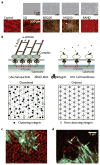Polymer microarray technology for stem cell engineering
- PMID: 26497624
- PMCID: PMC4811723
- DOI: 10.1016/j.actbio.2015.10.030
Polymer microarray technology for stem cell engineering
Abstract
Stem cells hold remarkable promise for applications in tissue engineering and disease modeling. During the past decade, significant progress has been made in developing soluble factors (e.g., small molecules and growth factors) to direct stem cells into a desired phenotype. However, the current lack of suitable synthetic materials to regulate stem cell activity has limited the realization of the enormous potential of stem cells. This can be attributed to a large number of materials properties (e.g., chemical structures and physical properties of materials) that can affect stem cell fate. This makes it challenging to design biomaterials to direct stem cell behavior. To address this, polymer microarray technology has been developed to rapidly identify materials for a variety of stem cell applications. In this article, we summarize recent developments in polymer array technology and their applications in stem cell engineering.
Statement of significance: Stem cells hold remarkable promise for applications in tissue engineering and disease modeling. In the last decade, significant progress has been made in developing chemically defined media to direct stem cells into a desired phenotype. However, the current lack of the suitable synthetic materials to regulate stem cell activities has been limiting the realization of the potential of stem cells. This can be attributed to the number of variables in material properties (e.g., chemical structures and physical properties) that can affect stem cells. Polymer microarray technology has shown to be a powerful tool to rapidly identify materials for a variety of stem cell applications. Here we summarize recent developments in polymer array technology and their applications in stem cell engineering.
Keywords: Elastic modulus; Polymer microarray; Stem cell; Surface chemistry; Surface topography.
Copyright © 2015 Acta Materialia Inc. Published by Elsevier Ltd. All rights reserved.
Figures








References
-
- Tang W, Becker ML. “Click” reactions: a versatile toolbox for the synthesis of peptide-conjugates. Chem Soc Rev. 2014;43:7013–7039. - PubMed
-
- Kane RS, Takayama S, Ostuni E, Ingber DE, Whitesides GM. Patterning proteins and cells using soft lithography. Biomaterials. 1999;20:2363–2376. - PubMed
-
- Ulman A. Formation and structure of self-assembled monolayers. Chem Rev. 1996;96:1533–1554. - PubMed
-
- Weissman I. Stem cell therapies could change medicine... if they get the chance. Cell Stem Cell. 2012;10:663–665. - PubMed
Publication types
MeSH terms
Substances
Grants and funding
LinkOut - more resources
Full Text Sources
Other Literature Sources
Medical
Research Materials
Miscellaneous

